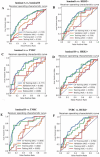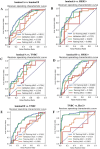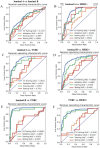Radiomics Integration of Mammography and DCE-MRI for Predicting Molecular Subtypes in Breast Cancer Patients
- PMID: 39990966
- PMCID: PMC11846489
- DOI: 10.2147/BCTT.S488200
Radiomics Integration of Mammography and DCE-MRI for Predicting Molecular Subtypes in Breast Cancer Patients
Abstract
Background: Accurate identification of the molecular subtypes of breast cancer is essential for effective treatment selection and prognosis prediction.
Aim: This study aimed to evaluate the diagnostic performance of a radiomics model, which integrates breast mammography and dynamic contrast-enhanced magnetic resonance imaging (DCE-MRI) in predicting the molecular subtypes of breast cancer.
Methods: We retrospectively included 462 female patients with pathologically confirmed breast cancer, including 53 cases of triple-negative, 94 cases of HER2 overexpression, 95 cases of luminal A, and 215 cases of luminal B breast cancer. Radiomics analysis was performed using FAE software, wherein the radiomic features were examined about the hormone receptor status. The performance of the model was evaluated using the area under the receiver operating characteristic curve (AUC) and accuracy.
Results: In multivariate analysis, radiomic features were the only independent predictive factors for molecular subtypes. The model that incorporates multimodal fusion features from breast mammography and DCE-MRI images exhibited superior overall performance compared to using either modality independently. The AUC values (or accuracies) for six pairings were as follows: 0.648 (0.627) for luminal A vs luminal B, 0.819 (0.793) for luminal A vs HER2 overexpression, 0.725 (0.696) for luminal A vs triple-negative subtype, 0.644 (0.560) for luminal B vs HER2 overexpression, 0.625 (0.636) for luminal B vs triple-negative subtype, and 0.598 (0.500) for triple-negative subtype vs HER2 overexpression.
Conclusion: The radionics model utilizing multimodal fusion features from breast mammography combined with DCE-MRI images showed high performance in distinguishing molecular subtypes of breast cancer. It is of significance to accurately predict prognosis and determine treatment strategy of breast cancer by molecular classification.
Keywords: breast cancer; magnetic resonance; mammography; molecular subtypes; radiomics.
© 2025 Yang et al.
Conflict of interest statement
The authors declare no competing interests in this work.
Figures




References
LinkOut - more resources
Full Text Sources
Research Materials
Miscellaneous

